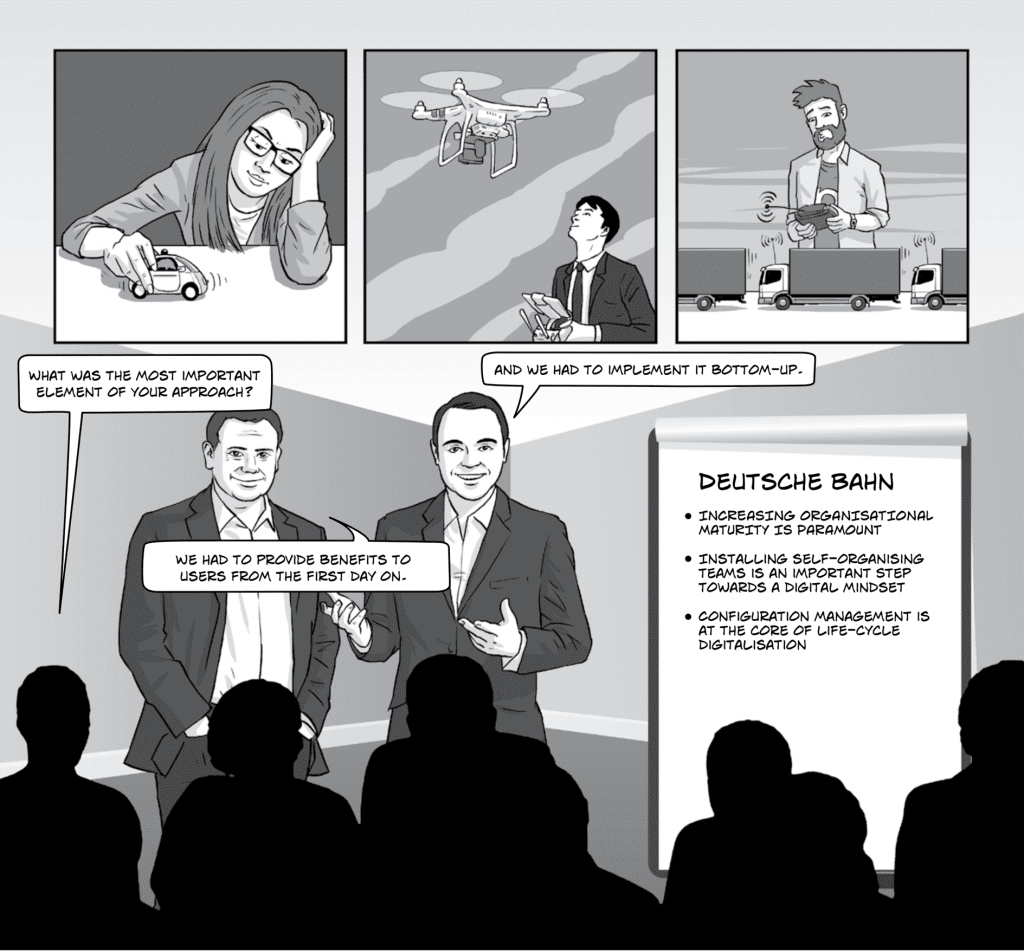Deutsche Bahn is an international logistics provider with 297,000 employees and 40 billion Euro turnover in 2015, operating in more than 140 countries
The organisation has traditionally been divided into markets and functions, and, as the main provider of railway services, is an enterprise with a long tradition and constant presence in Germany.
With digitalisation setting the pace in rail travel, and new competitors, such as bus operators, entering the German market in recent years, this image has started to crumble, initiating a strategic review process at Deutsche Bahn.
New technologies, such as autonomous electric vehicles, herald future change in transport.
These changes in market conditions are taken seriously by Deutsche Bahn, as reflected in the comprehensive group programme ‘Zukunft Bahn’, or ‘Future Railway’, initiated in 2016.[1] The analysis behind Zukunft Bahn came to the conclusion that major efforts are needed in digital transformation and suggested projects such as fully automated train operation and new data-driven business models. Additional investment of 233 million Euro in IT alone was announced for the time frame of 2016 to 2020 to ensure the necessary measures did not fall short. Zukunft Bahn highlighted that organisational complexity and business culture are among the greatest challenges Deutsche Bahn faces. To date, the company has been used to an organisational structure established to conduct projects running over a time span of several decades – e.g., projects like the exploitation of subgrades. Now the company faces the challenge of delivering at a digital speed.
This situation is also reflected in the organisation of Deutsche Bahn’s IT. In this respect the company is similar to most enterprises. Although it is qualified to implement modern technology, e.g., up-to-date application platforms or mobile front ends, these technologies are still used in traditional ways.
Manual processes and the sometimes-diverging business interests within the group shape the day-to-day business, making it difficult to meet urgent time-to-market requirements.
These requirements include linking functionalities beyond the dividing line of functional departments, increasing the speed of delivery, especially in combination with higher quality, and reusing building blocks to reduce complexity and cost.
As a consequence, Deutsche Bahn’s IT integrator, DB Systel, launched a bottom-up change initiative. ‘Managed Environment’ (ME) has the potential to fundamentally change the rules of how the life cycles of IT business components are managed and to guide Deutsche Bahn into a digitalised age.
The company decided not to start a top-down initiative due to the complexity of such a large organisation.
Instead, different entities within it pursued their own implementation programmes, the largest of them being the creation and promotion of ME as best practice (an in-depth discussion of starting small and scaling up a digital initiative is provided in ‘Managing for Digital’[2]). As ME started small, it was paramount to have a far-reaching thought-through vision. This vision comprises end-to-end life cycle management of Deutsche Bahn’s business applications and platforms, which would allow seamless, optimised processes from project inception to operation characterised by a high degree of automation and vendor independence.
With this in mind, DB Systel thought about the requirements necessary to build such a solution.
The greatest constraint within which the company had to plan was a lack of budget to buy huge DevOps solutions. Time restrictions that rendered huge tenders impossible were a further constraint.
It was obvious that a step-by-step approach would be necessary to deliver ME’s vision. DB Systel knew that a system of traditional implementation that forced digital processes on their employees would not work, and therefore any solution must be perceived as making the users’ day-to-day work easier.
It became clear that a configuration management system (CMS) needed to be at the core of the envisaged solution to document as-is and to-be scenarios of hardware and software.
Due to the restrictions mentioned above, the CMS had to be extremely lightweight, extendable, non-intrusive and technically independent of existing technology stacks. It was used to ensure 100% machine-readable descriptions and 100% automation, with build, deployment and test features built on top. The CMS also allowed IaaS as the basis of PaaS models and these in turn as the basis of SaaS models.[3] ME developed an XML-based language to describe components and a respective editor, which stored content in source control systems. This language was extremely simple, but capable of increasing the CMMI level to 3.
As a first step, ME started by educating employees in the advantages of digitalised structures, making them open to service thinking, e.g., considering IaaS and PaaS, or providing reusable building blocks to them, which could be combined.
The first recognised deliverable of ME was the automation of provisioning of environments, including (virtual) hardware and middleware, in addition to a reduction in delivery cycles from three months to three hours. ME’s first version of this PaaS product was a great success, with clients extensively using the offered service. Clients are now only a few clicks away from a new environment with ready-to-use middleware stacks from various vendors. A few months earlier this was unthinkable.
At the time of writing, DB Systel is working on a second major step. As part of their cloud migration strategy, DB Systel is utilising the same mechanisms to deploy business components in the environments that it has already provisioned with its automated tools. This also includes putting typical operational features in place, such as auto-scalability, monitoring and backup, without additional project expense. As the cherry on the cake, the envisaged solution is expected to be extendable into the planning phase to facilitate enterprise architecture planning, resulting in a measurable impact on the real world.
Looking ahead, DB Systel foresees the achievement of a higher CMMI maturity level.
To achieve this, organisational structures should move towards DevOps and self-organised teams and structures, away from Taylorism.
Furthermore, an enterprise must present suggestions for future development of the business culture, enthuse employees about anticipated changes and activate visions for the future, constantly educating employees. In the future, CMS and monitoring will be used to manage PaaS capacity, especially to reduce costs and increase system stability, generating independence from the IaaS provider. SaaS models will increasingly be applied. Business value engineering is being used to develop modern billing models and further life-cycle operations will support quality management. Lastly, sustainable changes will be imbedded into the business culture through self-organised teams, intentionally nurtured by the executive management to enhance innovation and efficiency.
_____
[1] Team Zukunft Bahn: ‘Zukunft Bahn – Gemeinsam für mehr Qualität, mehr Kunden, mehr Erfolg’, DB AG, 2016.
[2] Krafzig, D., Deb, M., Frick, M.: ‘Managing for Digital: Shape and Drive your Digital Transformation for Change [Executive Edition]’ (Digital Cookbook Series), Dr. Dirk Krafzig, 2021.
[3] IaaS = infrastructure as a service; PaaS = platform as a service; SaaS = software as a service.


